Racism and discrimination aren’t issues typically associated with surfing. But the sport is, forgive the pun, fairly whitewashed. And while things have progressed massively since, say, the 1960s – with Brazil as the dominant superpower, over 50 countries represented in the ISA’s most recent World Surfing Games, equal pay for the women’s WSL, and Mikey February as the first black surfer to don a CT jersey – there’s still a ways to go.
Enter the women of Textured Waves, a collective of female surfers of color doing their damnedest to empower non-white surfers (specifically women) to feel comfortable in the lineup. By embracing the color of their skin and the shape of their bodies, these women are challenging the surf industry’s conception of what the ideal “surfer chick” should look like. And they’re gaining traction, too, with a strong social media following, a blog discussing the adversity women of color face in the water, and surf meetups nationwide.
So, we had a discussion with the women of Textured Waves — Chelsea Woody, Danielle Black Lyons, Gigi Lucas, and Martina Duran — on a host of subjects ranging from the hurdles they’ve had to overcome in surfing, the message they hope to impart upon young girls, and the struggles African American women surfers face when it comes to hair. (Yep, it’s a big deal.) Keep scrollin’ to read the chat.
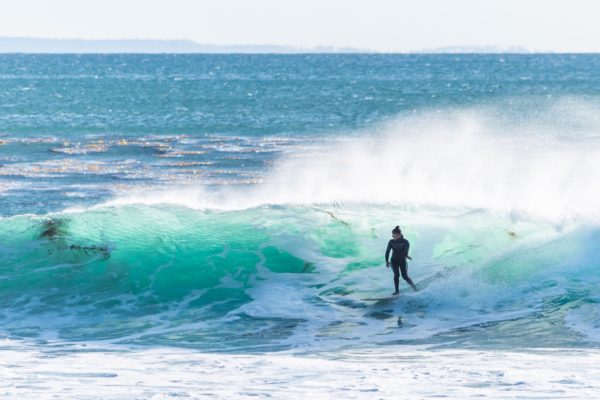
Chelsea Woody, one of the four cofounders of Textured Waves, with her foot on the gas. Photo: Jason Zullo
Surfline: How did this whole thing start?
Chelsea Woody: Good ol’ social media [Laughs]. It was social media and a shared bond over a lack of representation of folks who look like us and the absence of a place for us. If you Google or search hashtags for black surfers, there’s some folks out there. But they’re spread out around the world, and not really centrally organized. So we wanted to change that; we wanted to tell our story.
Gigi Lucas: If you Google image search ‘surfers,’ it doesn’t show people like us, As people who have been surfing for years, and for us not to be considered surfers in the mainstream – that’s an issue.
Being a woman surfer is already tough, given that the sport is so heavily male dominated. But how does being a woman of color add to that difficulty?
Danielle Black Lyons: People already look at you a certain way when you paddle out into a lineup as a woman. When you’re a woman of color, you get even more questioning looks from people. I think some of it boils down to curiosity. Other times people question your ability, which can be frustrating. I have to prove myself on every single wave I take, every session. It doesn’t matter where I am. It doesn’t matter how often I frequent that spot; I still have to show that I belong there.
Gigi: It’s a constant reminder of why we fell in love with the sport. It wasn’t for the approval of other people. It’s because we actually love surfing, and it is a battle sometimes going out to just enjoy the session. But we carry this badge wherever we show up. People are like, ‘oh she’s a black woman surfer. That’s an anomaly.’ And so there’s this heavy weight on our shoulders all the time.
Have you noticed any progress since you started surfing? Are people becoming more accepting?
Chelsea: It’s a mixed bag, for sure. Recently people are starting to acknowledge or finally recognize that there’s been this huge gap in diversity for so long. But we still have a long way to go. When you’re not exposed to surfing when you’re young, your chances of being on that world stage are so slim. If it’s not passed down to you, if your parents didn’t have access, it’s gonna take generations to fix. It doesn’t exist at a high performance level here in the states and that won’t change overnight.
Gigi: The skill gap is huge. I do think that emotionally and intellectually people are evolving. However, the action isn’t quite tethered to the acceptance yet. And I think it’s gonna take a while. It’s gonna take a while of sustained action in order to change the landscape of surfing.
“When it comes to women’s representation, it’s overly sexualized. It’s more focused on body parts and not skill. I want to see women shredding.”
Historically, what has the experience been like for women of color surfers?
Danielle: When you look at the history of this country, and you look at access to beaches and public pools and things like that, there’s a clear reason why there is this divide. The divide was built into this country. If you look at other countries that have coastal access, they don’t have this great divide that we have with black folks having a relationship with the water. I think that since these rules and regulations that have been built into this country, you’re seeing the effects of that divide.
Chelsea: Women of color have been surfing for a long time. Like Hawaiian women, Polynesian women. But not African American women. Andrea Kabwasa and Mary Mills, these are African American women. I think they had very similar experiences to us, but way more intense probably because it wasn’t as popular when they were surfing. It was totally a boy’s club. There wasn’t social media showing other surfers like them.
Gigi: Has it moved along since they started surfing? I would honestly say no. They still surf, and they love it just like we do. But can they paddle out at their homebreak and see another face that looks like theirs? Chances are no. Do they have to reach out and travel somewhere in order to surf with someone who looks like them? Chances are yes. So, in that sense, like I don’t think it has moved along that much.
But surfing has, for the most part, always been a counterculture sport. So with them being quote unquote anomalies in the sport, I don’t think that they were necessarily outcasts because they wanted to be in the water. We aren’t either. Do we have run ins? Absolutely. So I would say with those small comparisons, I don’t think that it’s changed much honestly.
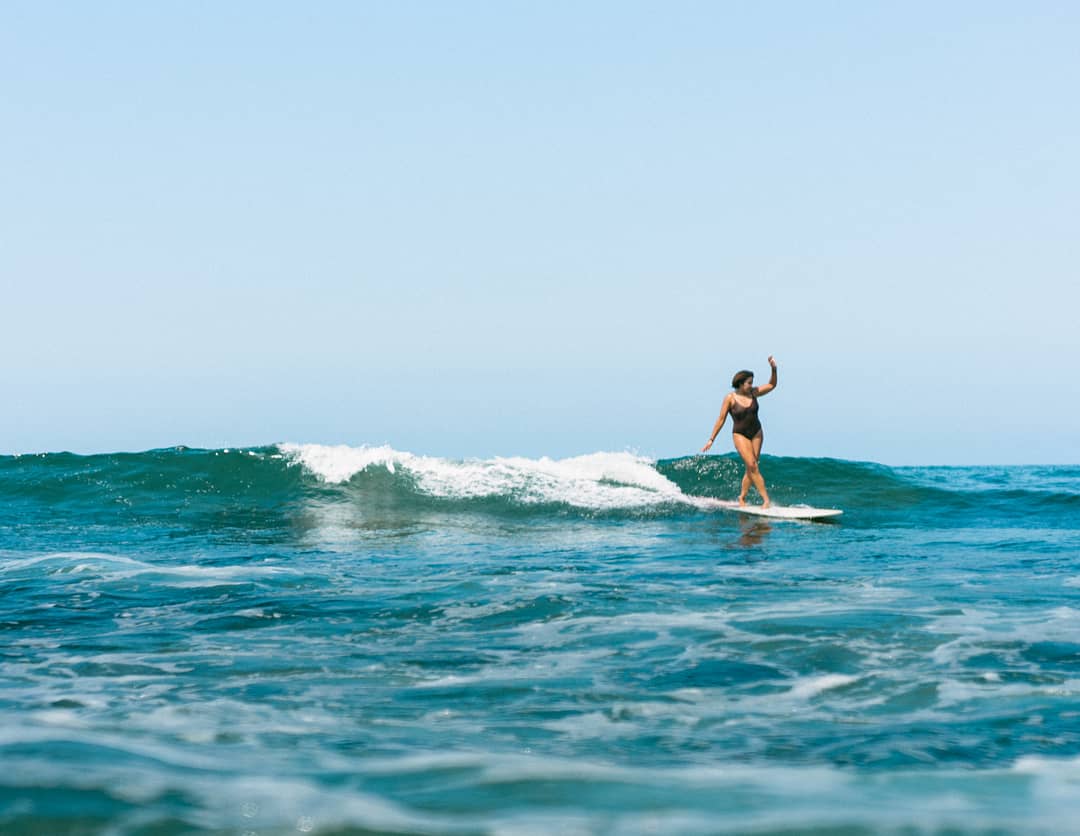
Danielle Black Lyons’ water dance. Photo: Jo Savage
Have you noticed different attitudes in the lineup in different parts of the world or country?
Gigi: I’m originally from Florida but just recently moved back after 20 years. When compared to a place like New York, there’s definitely more overt racism on the land. There are quite a few confederate flags flying high. Some of that divisive mentality does unfortunately make its way into the water, but not in an overt way and it’s few and far between. It’s them watching you, and waiting for you to fail. You feel it; it’s palpable. But you can’t take anything personally because at the end of the day, surfing is not about them. It’s about us and the ocean. Would it be easier if people didn’t really notice me and I can just surf? Absolutely. But that’s not the way it is.
What was the impetus for starting Textured Waves and what’s the goal?
Gigi: The reason we started this was to change the current narrative about black women in surfing. There was one particular individual who had the mic and it was painting a very negative picture of what African American women surfers here in the United States are. None of us had that same experience, although that was what the story that was being told. So, we were like: ‘hey guys, we don’t necessarily agree with this. Let’s put out something in addition to what’s already there to show a different perspective.’ And that’s what we’re doing.
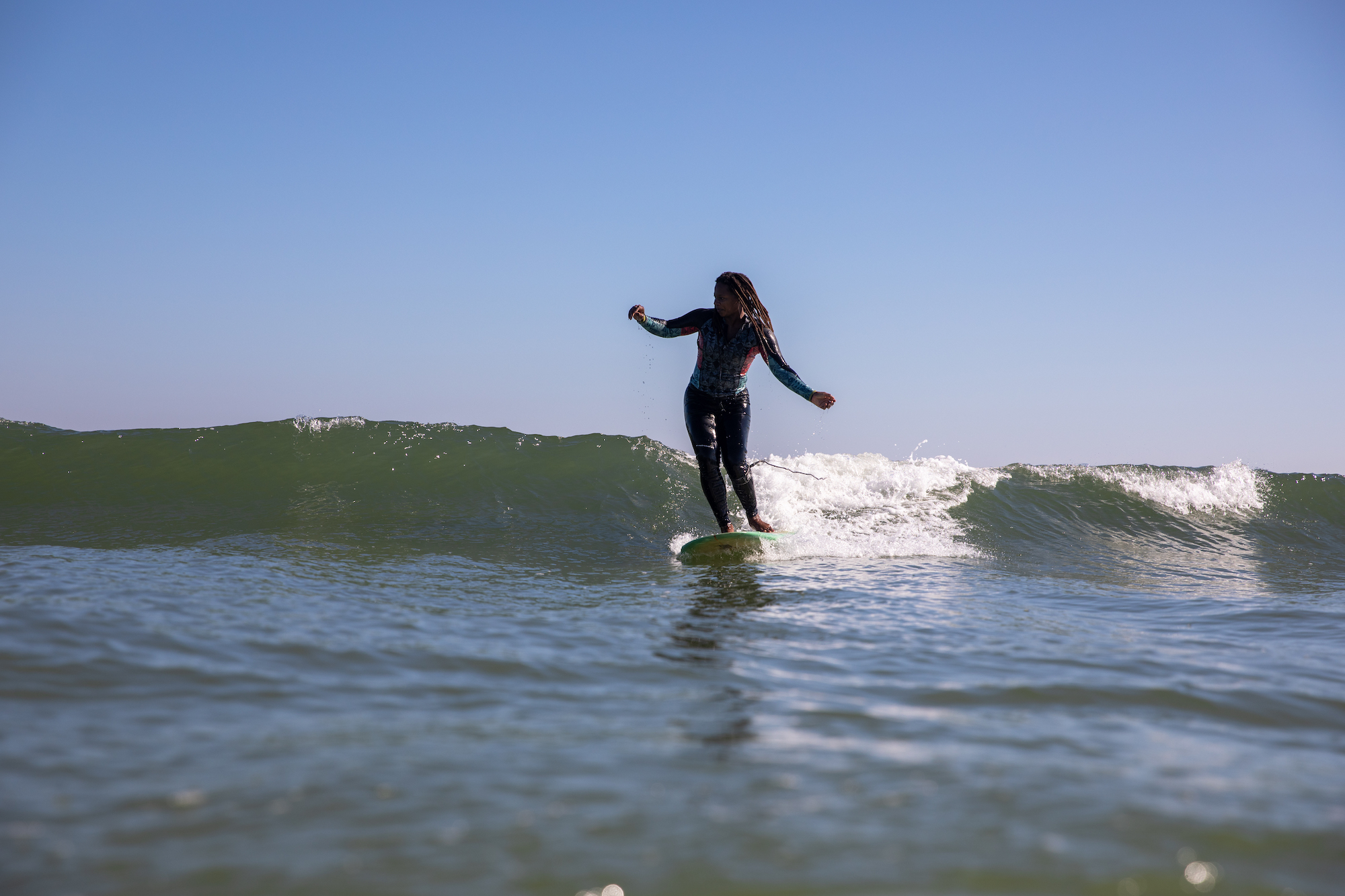
Gigi Lucas, the East Coast representative and co-founder of Textured Waves. Photo: Scott Cretul
What has the response been?
Danielle: I think people have been receiving it really well. The very first week we got messages from little girls saying, ‘we always wondered where the brown people were and where the women of color were in surfing.’ We couldn’t see girls who looked like us in surf media. Getting those messages from the younger generation was super encouraging for us. We knew we were doing something right. People were supporting us right away. And then, we were getting backing from bigger names in the industry like Leah Dawson and Sal Masakela.
I think having that visual, seeing people who look like you in the water, it’s huge. When we were young girls, we didn’t have that. There were no black prima ballerinas, there were no black Olympic swimmers. There were no WSL black surfers. So, if we can’t see that image, then we don’t know that it’s possible. It’s super important for those future generations to get that exposure.
There are a couple posts on the blog about hair. What’s the story with that?
Gigi: How long you got? [Laughs.]
Danielle: I don’t even know where to start with this. It’s a lot to unpack. For black people in general, there are so many negative associations with our hair. If it’s natural, it’s nappy; it’s not professional enough for the workplace. You see kids being sent home from school because they have braids in their hair or extensions. Dreadlocks aren’t professional enough for certain workplaces. So, our hair is our way of taking back our identity. And when you’re in the water, you go back to that state of your natural hair. You can’t go in the water with flat-ironed hair – it’s going to go back to its natural state.
So many people of color have deep rooted issues and trauma associated with their hair. But getting it wet, you have to let go of all that. That’s a huge part of being a surfer – self-acceptance and release of ego around your hair, that negative self-talk or other people telling you that your hair has to be a certain way. Black hair is beautiful.
Chelsea: I think one of the big things is the policing around our hair. There’s a societal pressure for you to look a certain way to be considered presentable. In this country, and in many places, that’s been with straight hair. So historically there’s been pressure to conform. Obviously you can’t do that when you’re in the ocean. There has been a lot of conditioning around how a black woman is supposed to look. And unfortunately, the way we came out of our mothers, naturally, has been deemed inappropriate. There’s still so much to unpack and to unteach there. What we see in mainstream media, especially when we were growing up, is straightened hair. You’re seen as rebellious if you’re wearing your hair in its natural state, when that’s the way you were born.
Gigi: Those challenges exist in every culture, like the ideology of what a woman is supposed to look like. But in this context, it’s who we are naturally in a world that isn’t naturally ours. It’s being able to accept who we are naturally when our own culture is telling us we should be something different. But then it’s also about going into a culture that says, ‘wait a minute, are you even supposed to be here?’ For us, it’s a doubly courageous thing to attack. It’s been an interesting journey, and to be able to go through it together has been a tremendous help. Personally, that ability to just say, ‘f*ck it. I’m just gonna be me.’ That’s been incredibly empowering. And if you don’t like it, that’s on you.
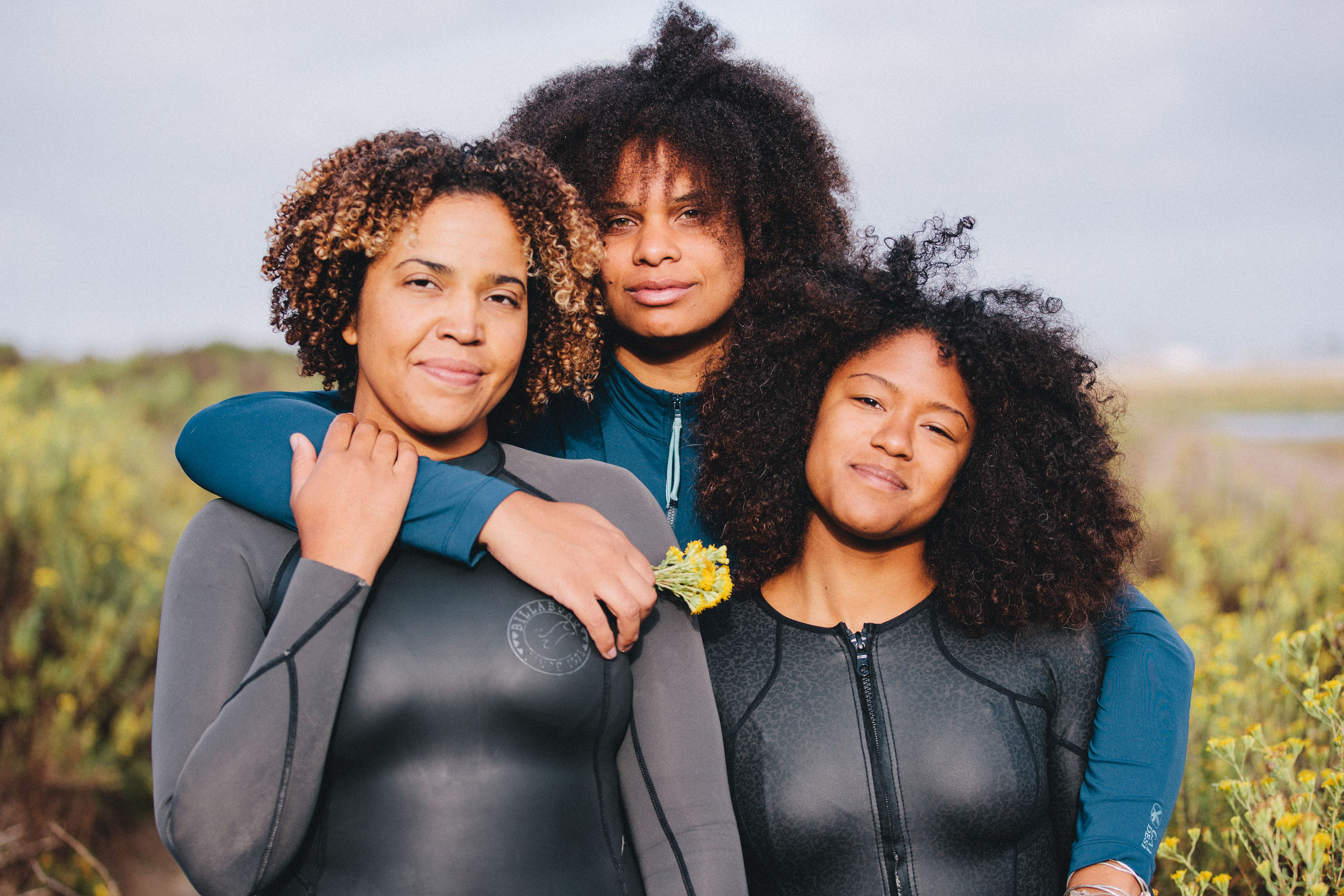
Natural hair, no problem. Danielle, Martina, and Chelsea embracing the locks they were born with. Photo: Brie lakin
In your opinion, what’s wrong with the surf world today?
Danielle: I think when it comes to women’s representation, it’s hyper sexualized with some brands focusing on body parts and less on skill. We’ve got this whole equal pay movement in surfing, which is fantastic, but it’d be great to see an emphasis on equal skills. I want to see women shredding, and I’d obviously love to see more diversity.
Gigi: There’s a lot of nepotism in the surf industry. It’s really about who you know and unfortunately really good surfers get overlooked. Let’s be real. Corporations in the U.S. and Australia pretty much drive the aesthetic of surfing. There is a huge discrepancy in skill levels to compete on the international level. But there’s still a need there in terms of representation. With the Olympics coming this summer, hopefully that’ll ring some bells. Hopefully we’ll be able to see surfing be more inclusive with other countries being involved in their representation of what they look like.
What’s right in the surf world, and how do you hope to influence the next generation of surfer girls?
Danielle: There are a lot of great organizations out there trying to get kids involved in surfing. There’s City Surf Project, Surfear Negra, Brown Girl Surf, and lots more. There are lots of people out there trying to do things that are beyond themselves and bringing up the next generation.
Gigi: With the one down here in Jacksonville, Surfear Negra, we are really trying to actually put the money into shortening that gap in terms of professional surfing. So, actually giving girls of color access to professional coaching. Like professional coaching from people who are actually in the circuit. It’s one thing to bring girls out of their environment for a day or a weekend, but to actually give them the tools to do it for a lifetime is a whole other thing. What we’re trying to do with Textured Waves is to start to shift what is seen in media. Representation is absolutely critical. Even for those girls who are geographically challenged, they can see people like them surfing, then they know it’s an option, and they can seek out these resources available.
What’s the future for Textured Waves?
Gigi: World domination. [Laughs.] In 10 or 20 years, I kind of hope there’s no need for us to exist in our current function. I hope there’s a really great community of surfers where we can come together and enjoy the ocean. I hope there’s no need for to ring the bell all the time about the lack of diversity.
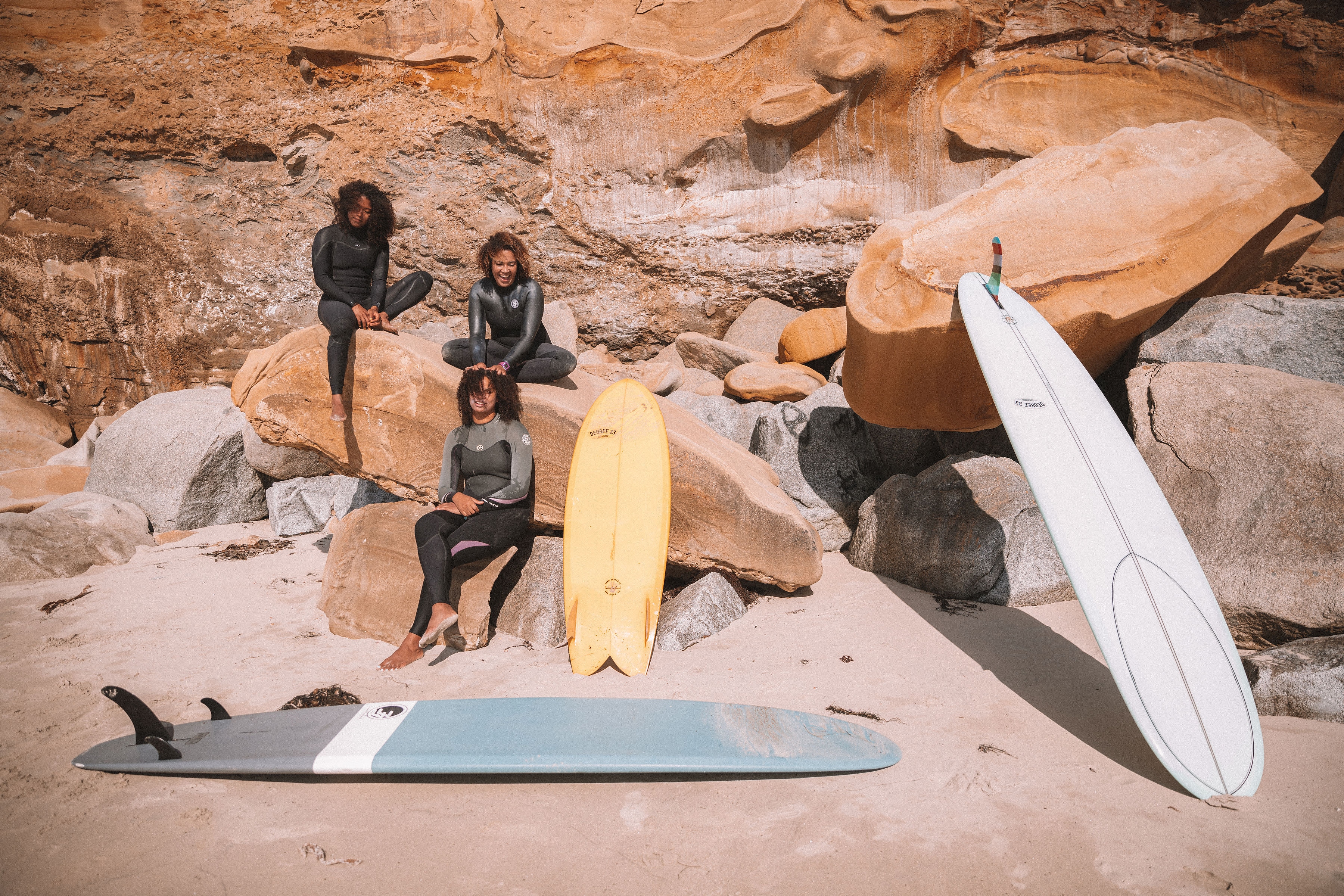
Chelsea, Danielle, Martina. Photo: Kat Carney





Recent Comments